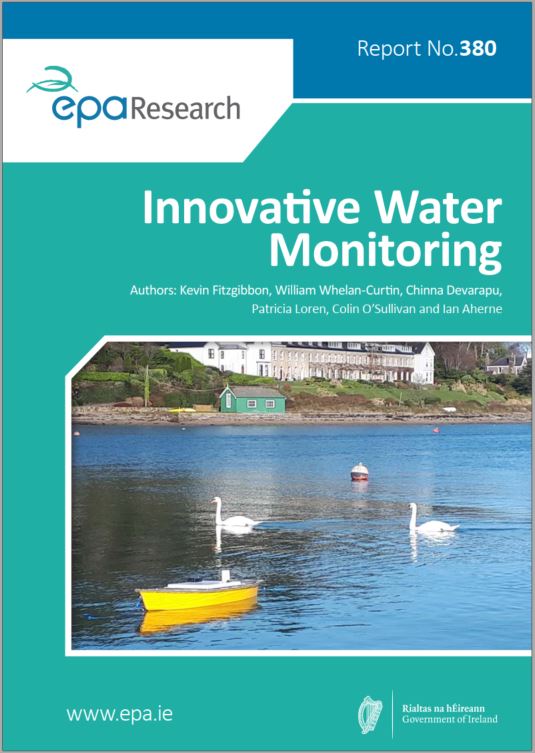Research 380: Innovative Water Monitoring
Authors: Kevin Fitzgibbon, William Whelan-Curtin, Chinna Devarapu, Patricia Loren, Colin O’Sullivan and Ian Aherne
Summary: The Innovative Water Monitoring project aimed to create an additional innovative sensing system for real-time detection of water quality parameters, to support the existing water quality monitoring policies, programmes and requirements under the Water Framework Directive, the Bathing Water Quality legislation, etc. It has demonstrated the ability to detect two such parameters, nitrates and Escherichia coli (E. coli), using the system.

Project Highlights
Watch the project highlights video
Identifying Pressures
The European Union (EU) Water Framework Directive, transposed into national legislation, has led to the implementation of water quality monitoring programmes in Ireland and across the EU. In Ireland, high nutrient concentrations in watercourses and periodic pathogen contamination of bathing waters continue to be causes of concern. Apart from knowing where and when to take samples for analysis, one of the biggest challenges for authorities is the time required and cost of investigating whether or not the water quality is safe for drinking, bathing or other uses. The methods usually involve field collection and transportation of samples to a laboratory, and in the case of some tests, such as for pathogens, sample preparation by culturing, followed finally by analysis. These testing challenges apply for nutrients, pathogens and other hazardous compounds. Together, these factors act as drivers in the effort to develop low-cost, low-maintenance, reusable water quality monitoring sensors that can act continuously in real time, detecting the presence and concentration of relevant parameters in a cost-effective manner.
Informing Policy
The project aimed to create an additional innovative sensing system for real-time detection of water quality parameters, to support the existing water quality monitoring policies, programmes and requirements under the Water Framework Directive, the Bathing Water Quality legislation, etc. It has demonstrated the ability to detect two such parameters, nitrates and Escherichia coli (E. coli), using the system. This result provides further support for the concept of using networks of catchment monitoring stations, to act as real-time “red flag” warning systems for pollution events. The outcomes of the project support a policy of developing dispersed autonomous sensing networks in river catchments and bathing areas, using suitable ranges of sensors. To enable such networks, consideration should be given to the most suitable communications infrastructure and protocols to adopt, in terms of cost, data transmission requirements and communications reliability. Creating comprehensive multi-modal communication gateway networks could be considered, to enable such whole-of-catchment monitoring.
Developing Solutions
Previous research indicated that Raman spectroscopy (RS) combined with artificial intelligence (AI) methods could be a feasible way to detect certain target analytes in water. The project aimed to use these technologies to develop an innovative, low-cost autonomous system for detection of water-borne nutrients (nitrates and phosphates) and pathogens (specifically E. coli), and which is capable of operating in close to real time. A Lab-on-Chip model was envisaged as the ideal project outcome. An iterative approach allowed parallel progress on different aspects of the system, which mitigated the technical challenges of creating the Lab-on-Chip version.
The project has verified the hypothesis by developing and demonstrating Watermon, an end-to-end RS-based detection system that uses AI models to rapidly detect nitrates and E. coli. The AI model for nitrates was very effective (c. 99% accuracy) at detecting nitrates at 30 mg/l or above in river and drinking water. The E. coli AI model was able to detect the pathogen at 250 colony-forming units with an accuracy of c. 83%. At such levels, it was not possible to identify positive E. coli samples by traditional analysis of the data, i.e. inspection of a single spectrum, underscoring the superior ability of the AI model, albeit at relatively higher concentrations.
https://www.epa.ie/media/epa-2020/research/epa-funded-research/Report_cover_380.jpg